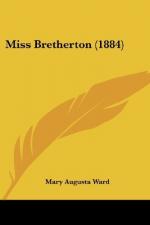These were the ideas on which this little sketch was based, and in working them out the writer has not been conscious of any portraiture of individuals. Whatever attractiveness she may have succeeded in giving to her heroine is no doubt the shadow, so to speak, of a real influence so strong that no one writing of the English stage at the present moment can easily escape it; but otherwise everything is fanciful, the outcome, and indeed, too much the outcome, of certain critical ideas. And in the details of the story there has been no chronicling of persons; all the minor and subsidiary figures are imaginary, devised so as to illustrate to the best of the writer’s ability the various influences which are continually brought to bear upon the artist in the London of to-day. There are traits and reminiscences of actual experience in the book,—what story was ever without them? But no living person has been drawn, and no living person has any just reason to think himself or herself aggrieved by any sentence which it contains.
CHAPTER I
It was the day of the private view at the Royal Academy. The great courtyard of Burlington House was full of carriages, and a continuous stream of guests was pressing up the red-carpeted stairs, over which presided some of the most imposing individuals known to the eyes of Londoners, second only to Her Majesty’s beefeaters in glory of scarlet apparel. Inside, however, as it was not yet luncheon-time, the rooms were but moderately filled. It was possible to see the pictures, to appreciate the spring dresses, and to




